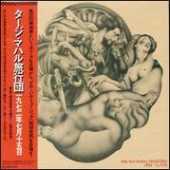The Pharaoh's First Stand
The names that Pharaoh Sanders (aka Ferrell Sanders) has played with would likely astound anyone remotely interested in jazz. The stylistic impulses that he has followed have made him an important part of music history. Beginning his career at a time when not only musical changes were taking place, but social ones as well, Sanders embraced a sort of mystical humanism that imbued his playing with a range of colorful tonalities and immense feeling unable to be replicated by his peers.
He’s lived in the South, the Bay area and for stints in New York as well. And it’s that last place that in 1964, John Coltrane happened to hear him perform. That appearance changed the trajectory of his career – and probably Coltrane’s as well.
Sanders’ tenure with Coltrane and his band led to an association with Alice, his wife. And after the passing of his boss, Alice Coltrane and Sanders worked on a number of land mark ‘60s jazz recordings, injecting a sense of eastern religiosity into the mix of Black American culture.
Since then, Sanders has continued recording and toured incessantly. And to celebrate the New Year’s crowning, Sanders has scheduled a three day, four set stand at the amenable Yoshi’s in Oakland (and yes, the location needs to be specified as a result of an SF proper location being established.)
And from January 2nd through the 4th, you can see Sanders as he works through his classic compositions and blows a few free notes into the New Year’s air. There’s even a matinee show on Sunday, so bring out the little ones.
Tale of the Tape - Fielders vs Teixeira
Okay - I’m completely lost at this point. Your logic is that signing Tex for (minimum) 8 years - $160 million is GOOD for the team long term. This would be the 29-36 age seasons for Tex. Tex has TWO seasons of hitting 150+ (150 and 151 at age 27 and 28). The mega-money starts immediately. But, signing Fielder would be bad. Fielder is only turning 25. Fielder posted a 156 OPS+ season at age 23, (128 at age 24). Fielder is currently under contract thru 2011 (arb elligible), so the grossly stupid money isn’t even on the table until 2012. But FIELDER is the one who isn’t good because of the *TIMING??* Doc, I love your writing. I know you’re incredibly bright. I’ve learned a ton from reading your insights. But I gotta ask … in your day job, did somebody drop a hammer on your head?!? Mind you - I could easily accept the concept that having to TRADE for Fielder is a bad idea. But for the life of me I cannot grasp the concept that you would consider that getting the THREE BEST SEASONS of a players career, at bargain basement cost, (with juicy draft picks to follow, IF you decide he’s too pricey come 2012), is WORSE than snagging the guy who is likely to have just HAD the two best seasons of his career, and who there is basically no way of dumping gracefully, in the event he swoons quickly.Yeah, Sandy. I'm amused by our disconnect on this one. ............ I don't see Fielder as nearly the hitter, going forward, that Mark Teixeira is. I believe that Prince Fielder had one great year, and is now going to settle in as something much less than that. It won't surprise me in the least to see the out-of-shape Fielder run a Richie Sexson career from here to the wire. A precedent here is Prince's dad Cecil, who had one spectacular season at age 26, and then .... well, had a Richie Sexson Lite career from there. Cecil's OPS+ rates, after his 167 season:
Age 26 - 167 (note Prince's 156 in 2007, albeit at age 23) Age 27 - 133 (note Prince's 128 last year) Age 28 - 117 (that would be 2009 for Prince) Age 29 - 124 Age 30 - 113 Age 31 - 111 Age 32 - 108 Age 33 - 101 Age 34 - 86 and done....................... And, Fielder would have to survive an NL-to-AL transition filter. ALL hitters, and pitchers, unless they're Albert Pujols or something, face the possibility of being nuked when promoted to the more difficult league. I don't *expect,* exactly, that Prince will take a hit from coming to the AL. But he might! And that's the problemo. Boras is going to require that you pay as though there were no NL-AL transition whatsoever. .Teixeria on the other hand is a COMPLETELY PROVEN commodity in the AMERICAN League. When you lay out the $$$$$ for Teixeira, you know what you are getting. Many of you guys don't trust Teixeira; that's your judgment. Virtually all good ML franchises side with Dr. D on this one -- the Red Sox trust Teixeira's future, and the Angels do, and the Yankees do, and FWIW the Orioles (loathe to spend a buck) do. You guys see Teixeira as "a 130 OPS+" hitter going forward. That's your call. If I thought Mark Teixeira were a 130 OPS+ hitter with a good glove, I wouldn't be paying 8 x $23MM either. But you amigos are the only ones around who see Tex as a 130 guy. :- ) Right now he's a 150 guy. He may taper to 130 as the years go on, which is fine with me and fine with Theo Epstein. . === Addicted to Glove, Dept. === As you know, Dr. D doesn't consider defense 50% of a ballplayer's value :- ) but there is a big difference between taking a 140 hitter and SUBTRACTING value from there, and taking the same 140 hitter and ADDING value from there. Teixeira brings defense that AMPLIFIES his value. ................ As a completely separate issue, Teixeira brings leadership, is the face of the franchise -- you can set your franchise "Brand" on Tex. ................. I trust Teixeira's production in the American League. I don't trust Prince Fielder to provide MVP seasons from here, especially in the American League. But Scott Boras is going to want you to pay as though Fielder just had two consecutive 150 OPS+ seasons, and 5 consecutive All-Star seasons, in the AL. I could be wrong, of course. Maybe Fielder will go on to provide legit superstar numbers from here. But I think he'll be lucky to have a Richie Sexson career. I don't put Fielder anywhere near Tex's zip code as an overall commodity. Cheers, jemanji ............... image: http://assets.espn.go.com/i/page2/photos/050425fielder.jpg
Value of Low Glycemic Index Diet Proven
The Return of the Light
vintage breyer collection
hi
Pioneers of Metal
If I were to talk about Heavy Metal, I would talk about excellent music, guitar riffs, fantastic vocals, the look, the feel, the raw edge and of course, being true to yourself.
But everything has a beginning and for Heavy Metal that legendary starting point was Judas Priest.
Fair enough, there were other bands, other awesome singing groups around. But keep in mind, most of them were still heavily influenced by the Blues.
Who put the Metal in Rock and fused it to be Heavy Metal? The Metal Gods themselves. That's right, that was Judas Priest.
In this particular instance I want to point out one particular song from their legendary album, British Steel – Breaking the Law.
While almost all the songs in this must-have album were important, in that they set the pace, look and feel for Heavy Metal genre, this particular one is represents one significant trait of early Metal music – it's timeless; it still applies to present day issues.
To begin with, let's get the obvious out of the way. It's true; the official video for Breaking the Law was cheesy. Guys drive into a bank and steal a record album. While playing guitar no less.
Given various misconceptions about Metal, it is worthwhile to point out that this song is in no way endorsing people to commit crime. A quick glance at the lyrics and quiet pondering over the documentary about the British Steel album reveals much about this song.
For a bit of background, do recall that when the album came out in 1980, United Kingdom was facing rough economic times. Unemployment, problems in mines, a strict and scary PM in the form of Margaret Thatcher ... it was a time of upheaval.
So is it any surprise that the song, nay the whole album has underlying tones of youthful rebellion, disillusionment with current situation and the rather strong metal theme (quick question: how many in the band worked in or lived within a mining community?).
And of course, the most important bit about metal – the music. Metal was and is and should not be about pristine model looks, lip syncing and an overall focus on the vocals. Rather, it is about breathtaking guitar riffs, no, make that twin guitars adding to the flow. In fact, remember, this song has one of the greatest guitar riffs of all time. In addition to this, note that Judas Priest was one of the first bands to introduce the dual guitar playing concept which has now become a staple feature in metal bands.
Coming back to the topic of British Steel and how they defined a genre - metal is also about being able to play an instrument; no wait, make that being able to play an instrument really well. And of course, a singer whose voice captivates the audience whereby it also complements the whole song.
It's right about time to talk about Rob Halford; let's face it, he has one of the best vocal ranges in the genre. And while Breaking the Law might not bring out his full potential, one of the features that carries the momentum of the song is his powerful voice.
How else does Breaking the Law represent the genre? It's about having fun, being true to yourself; it's about the underdog and standing up for what you believe in; it's about playing music that is an expression of your own feelings.
That just about sums up Breaking the Law.
Please don't buy- adopt instead!
Gil Herron (R.i.P.)
If not for Gil Scott-Heron and the Last Poets (of course) hip hop would look drastically different than it does today. Rap might utilize totally different source samples. It might not have the same potential ability to affect politics and society. It might just be totally different. Without The Revolution Won’t Be Televised and the rest of Scott-Heron’s catalog, the course of American music might be drastically changed. It’s just not something that one would really want to consider seriously.
Scott-Heron has always been a voice to be heard over the din, but recently that voice was quieted with the news of his father’s death. Gil Heron was 86.
Born in Kingston, Jamaica, Heron would eventually live in a multitude of disparate locales from Canada to Scotland. These moves were frequently made without his wife , they were divorced, or son.
In 1946 Heron began playing professional soccer in the US, but soon his talents were spotted by the Celtic football club out of Scotland. He made the move Europe alone. But when he arrived he found that he was in the middle of becoming the first black player in the league and thusly was dubbed the “Black Arrow”. Could this have affected Gil Scott-Heron’s outlook on race? Perhaps it did. But did it spur him on to become a politically minded performer. It’s likely.
After his athletic career had passed him, Herron turned to embrace his artistic side by immersing himself in photography – a form of expression that his son could certainly relate to.
Branyan, Dunn, and TTO Hitters
TTO players are greatly valued (overvalued?) by statheads, because none of the Three True Outcomes are measured very well by batting average, the historic measure of offensive performance. Walks are not in BA at all, strikeouts are no worse than any other kind of out (and superior to GIDPs), and homers only count as much as singles when measured by BA. Theoretically, a TTO player would thus be underrated — cheaper than a high-average player, but far more productive.Baseball purists are subconsciously offended by the strikeout. (They used to be consciously offended.) They see a guy who swings and misses a lot as "high risk," although of course every hitter is out most of the time anyway. A TTO player feels unreliable. ……………………… Q. Where do Branyan and Dunn rank on the TTO scale? A. Here are the highest career % of TTO in the majors:
57.9% - Jack Cust (going into 2008) 53.2% - Russ Branyan (going into 2008) 52.1% - Dave Nicholson, 1960's 50.0 - Melvin Nieves, 90's 49.9 - Adam Dunn (going into 2008) 49.7 - Rob Deer, 1984-96 46.3 - Jim Thome, current 45.6 - Bo Jackson, 80's 45.4 - Mark McGwire, 80's 90's 44.3 - Mickey Tettleton, 80s 90's 44.1 - Sam Horn, 1987-1995 43.3 - Jay Buhner, 1987-2000 42.9 - Gorman Thomas, 70's 80'sThe all-time single-season high used to be: 60.2%, by Branyan; I didn't check whether Cust has since exceeded that. …………………. Get perspective on this, now: In over 50% of Dunn's and Branyan's AB's, the defense could literally have been playing with only the P and C. The defense could (theoretically of course) have walked off the field in the typical Dunn or Branyan AB. …………………… Q. Why do TTO players get the bum rap that they can't hit a curve? A. Because most of them will not, under any circumstances, swing at a ball outside the strike zone. ML pitchers do throw guys like Cust, Branyan and Dunn blizzards of offspeed pitches. Watch a game sometime. There's a problem, though. Usually when a major league pitcher throws a curve, it is a ball or a sloppy strike that is dangerous to the defense. Which is why TTO hitters walk so much. Pitchers tend to nibble with offspeed stuff. It sounds very easy to throw nothing but curve, change, curve, change – often they do. Sometimes that's a walk, sometimes a K. You think Dunn, Branyan, and Cust walk so much just because the bats are glued to their shoulders? You think Willie Bloomquist could go up, stand motionless taking pitches, and walk 100 times a year? :- ) ................... But bear in mind too, that when you hang that curve, Branyan and Dunn will hit it out. It's not that ML pitchers forget that they shouldn't throw Branyan and Dunn centered fastballs. It's just that when they get to 3-and-1 with those curve balls, and 1B is occupied, they are forced to come in and take their chances. That's why those guys average 40 homers per 550 AB's. ……………………… Q. What do you expect from a Russell Branyan in Safeco? A. As follows:
109 - Branyan's career OPS+ 120 - Branyan's OPS+ since he turned 28 (about the year Cust got good) 138 - Branyan's OPS+ last year 130 - Not a bad bet for 2009 in SafecoYou notice that Branyan spent the year playing for Jack Zduriencik, and Dr. Zoidberg got Branyan in here so fast you didn't even see Z's arm move. You gotta be bullish on Branyan for 2009. . Q. For Adam Dunn? A. Nobody denies any more that Dunn is an elite hitter. He's got a career 130 OPS+ .... if you added 10 points for the fact that he'll now be in his ideal park, you'd be talking 140... 140 OPS+ ? That's Ken Griffey Jr's lifetime OPS+. It's Mike Piazza's, Reggie Jackson's and David Ortiz'. Give Dunn that pitcher's park/TTO wind at his back and if he jumps up a notch, you've got a legit MVP hitter. . Q. Have the Mariners been friendly to Three True Outcomes players? A. This has definitely been part of their problem. They're probably the most extreme "purist" club in the majors and as such, they hate K's (and undervalue BB's). Even if the old Mariners had a Cust or Petagine or Branyan available somewhere, they'd have loathed him. Oh, wait... The old-school Mariners disliked strikeouts, and so they disliked deep counts and BB as well -- they avoided TTO players. ..., and so the effects of Safeco on their (contact) hitters was magnified. HR/BB/K hitters are precisely the kind of hitter who isn't hamstrung by Safeco Field, or by any ballpark. ...Jack Cust -- a journeyman minor leaguer by definition -- went into that tough park in Oakland and immediately posted a 147 and 132 OPS+. Those are (post-2005) Vladimir Guerrero performances -- wind-aided by the fact that Cust was a TTO hitter in a pitcher's park. The Seattle Mariners should grab every decent TTO hitter that they can get their hands on, and forget the strikeouts. Now that Jack Zduriencik is in charge, maybe they will. Cheers, Dr D .


